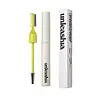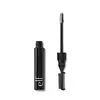What's inside
What's inside
 Key Ingredients
Key Ingredients

No key ingredients
 Benefits
Benefits

 Concerns
Concerns

 Ingredients Side-by-side
Ingredients Side-by-side

Water
Skin ConditioningAcrylates Copolymer
Synthetic Beeswax
Emulsion StabilisingGlycerin
HumectantPvp
Emulsion StabilisingCopernicia Cerifera Wax
Butylene Glycol
HumectantHydrogenated Polyisobutene
Emollient1,2-Hexanediol
Skin ConditioningPalmitic Acid
EmollientStearic Acid
CleansingPentylene Glycol
Skin ConditioningAlcohol
AntimicrobialC14-22 Alcohols
Emulsion StabilisingTromethamine
BufferingC12-20 Alkyl Glucoside
EmulsifyingXanthan Gum
EmulsifyingHydroxyethylcellulose
Emulsion StabilisingSodium Dehydroacetate
PreservativeGlucose
HumectantPerilla Ocymoides Leaf Extract
TonicOryza Sativa Extract
AbsorbentGlycine Max Seed Extract
Skin ConditioningWater, Acrylates Copolymer, Synthetic Beeswax, Glycerin, Pvp, Copernicia Cerifera Wax, Butylene Glycol, Hydrogenated Polyisobutene, 1,2-Hexanediol, Palmitic Acid, Stearic Acid, Pentylene Glycol, Alcohol, C14-22 Alcohols, Tromethamine, C12-20 Alkyl Glucoside, Xanthan Gum, Hydroxyethylcellulose, Sodium Dehydroacetate, Glucose, Perilla Ocymoides Leaf Extract, Oryza Sativa Extract, Glycine Max Seed Extract
Water
Skin ConditioningCeteareth-30
CleansingGlycerin
HumectantAcrylates Copolymer
Paraffin
PerfumingMicrocrystalline Wax
Emulsion StabilisingButylene Glycol
HumectantHydrogenated Polyisobutene
EmollientParaffinum Liquidum
EmollientEuphorbia Cerifera Wax
Copernicia Cerifera Cera
EmollientPvp
Emulsion StabilisingPalmitic Acid
EmollientStearic Acid
CleansingAlcohol
AntimicrobialPhenoxyethanol
PreservativePolysorbate 80
EmulsifyingAminomethyl Propanol
BufferingHydroxypropyl Methylcellulose
Emulsion StabilisingXanthan Gum
EmulsifyingTocopheryl Acetate
AntioxidantEthylhexylglycerin
Skin ConditioningDisodium EDTA
Hydrolyzed Wheat Protein
Skin ConditioningHydrolyzed Soy
Skin ConditioningHydrolyzed Soy Protein
HumectantHydrolyzed Corn Protein
Skin ConditioningSodium Chloride
MaskingWater, Ceteareth-30, Glycerin, Acrylates Copolymer, Paraffin, Microcrystalline Wax, Butylene Glycol, Hydrogenated Polyisobutene, Paraffinum Liquidum, Euphorbia Cerifera Wax, Copernicia Cerifera Cera, Pvp, Palmitic Acid, Stearic Acid, Alcohol, Phenoxyethanol, Polysorbate 80, Aminomethyl Propanol, Hydroxypropyl Methylcellulose, Xanthan Gum, Tocopheryl Acetate, Ethylhexylglycerin, Disodium EDTA, Hydrolyzed Wheat Protein, Hydrolyzed Soy, Hydrolyzed Soy Protein, Hydrolyzed Corn Protein, Sodium Chloride
 Reviews
Reviews

Ingredients Explained
These ingredients are found in both products.
Ingredients higher up in an ingredient list are typically present in a larger amount.
Acrylates Copolymer is used as a film-forming agent and texture enhancer.
After applied, Acrylates Copolymer forms a thin film cover that helps skin feel more soft. It can help sunscreens become more water-resistant.
It is also used to make a product more thick.
Learn more about Acrylates CopolymerAlcohol comes in many different forms. Different types of alcohol will have different effects on skin. This ingredient is usually an astringent alcohol.
These alcohols are drying on the skin. They may strip away your skin's natural oils and even damage your skin barrier. Astringent alcohols may also irritate skin.
Other types of astringent alcohols include:
According to the National Rosacea Society based in the US, you should be mindful of products with these alcohols in the top half of ingredients.
Any type of sanitizing product will have high amounts of alcohol to help kill bacteria and viruses.
Fatty alcohols come from plant oils such as coconut oil. These can help hydrate the skin and are non-irritating. Some fatty alcohols include cetyl and stearyl alcohol.
Learn more about AlcoholButylene Glycol (or BG) is used within cosmetic products for a few different reasons:
Overall, Butylene Glycol is a safe and well-rounded ingredient that works well with other ingredients.
Though this ingredient works well with most skin types, some people with sensitive skin may experience a reaction such as allergic rashes, closed comedones, or itchiness.
Learn more about Butylene GlycolGlycerin is already naturally found in your skin. It helps moisturize and protect your skin.
A study from 2016 found glycerin to be more effective as a humectant than AHAs and hyaluronic acid.
As a humectant, it helps the skin stay hydrated by pulling moisture to your skin. The low molecular weight of glycerin allows it to pull moisture into the deeper layers of your skin.
Hydrated skin improves your skin barrier; Your skin barrier helps protect against irritants and bacteria.
Glycerin has also been found to have antimicrobial and antiviral properties. Due to these properties, glycerin is often used in wound and burn treatments.
In cosmetics, glycerin is usually derived from plants such as soybean or palm. However, it can also be sourced from animals, such as tallow or animal fat.
This ingredient is organic, colorless, odorless, and non-toxic.
Glycerin is the name for this ingredient in American English. British English uses Glycerol/Glycerine.
Learn more about GlycerinHydrogenated Polyisobutene is a synthetic polymer. Polymers are compounds with high molecular weight. Hydrogenated Polyisobutene is an emollient and texture enhancer.
In one study, Hydrogenated Polyisobutene showed better skin hydration levels than Caprylic/Capric Triglyceride. As an emollient, it helps keep your skin soft and hydrated by trapping moisture in.
Hydrogenated Polyisobutene is often used as a mineral oil replacement.
Learn more about Hydrogenated PolyisobutenePalmitic Acid is a fatty acid naturally found in our skin and in many plant and animal sources. In cosmetics, it is usually derived from palm oil. It serves many purposes in skincare, acting as a cleanser, emollient, and emulsifier.
As an emollient, palmitic acid helps soften and smooth the skin by preventing water loss. In cleansers, it helps remove oil and dirt while creating foam.
Its emulsifying properties help stabilize products by keeping water and oil-based ingredients from separating.
This may not be suitable for fungal acne-prone skin, as fatty acids like this can sometimes trigger breakouts in sensitive individuals.
Learn more about Palmitic AcidPvp is a water-soluble synthetic polymer and common hairstyling ingredient. It is a film-forming ingredient and used to "hold" specific shapes of hair.
Pvp is less effective in high-humidity. It tends to draw moisture, but this moisture dismantles the structure and "hold".
Stearic Acid is a fatty acid. It is an emollient, emulsifier, and texture enhancer.
As an emollient, stearic acid helps soften skin. It aids the skin's protective barrier by preventing water loss. It also provides a gentle cleansing effect without stripping away natural oils.
Stearic acid may also be used to enhance the texture of products. It can add volume and stabilize ingredients such as water and oil. This can help water and oil ingredients from separating.
Sources of stearic acid include animal or vegetable fats/oils such as coconut or shea. It can be naturally found in butter, cocoa butter, shea butter, vegetable fats, and animal tallow.
This ingredient may not be Malassezia folliculitis, or fungal-acne safe.
Learn more about Stearic AcidWater. It's the most common cosmetic ingredient of all. You'll usually see it at the top of ingredient lists, meaning that it makes up the largest part of the product.
So why is it so popular? Water most often acts as a solvent - this means that it helps dissolve other ingredients into the formulation.
You'll also recognize water as that liquid we all need to stay alive. If you see this, drink a glass of water. Stay hydrated!
Learn more about WaterXanthan gum is used as a stabilizer and thickener within cosmetic products. It helps give products a sticky, thick feeling - preventing them from being too runny.
On the technical side of things, xanthan gum is a polysaccharide - a combination consisting of multiple sugar molecules bonded together.
Xanthan gum is a pretty common and great ingredient. It is a natural, non-toxic, non-irritating ingredient that is also commonly used in food products.
Learn more about Xanthan Gum